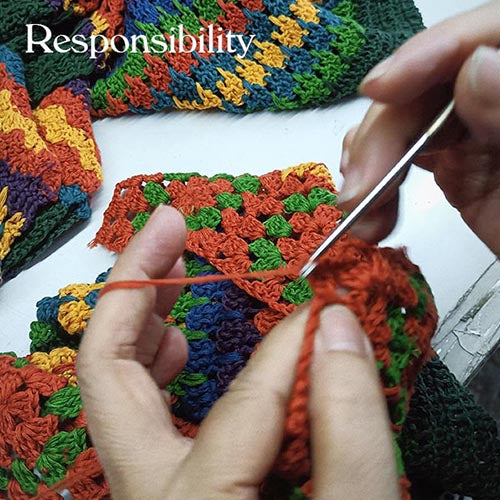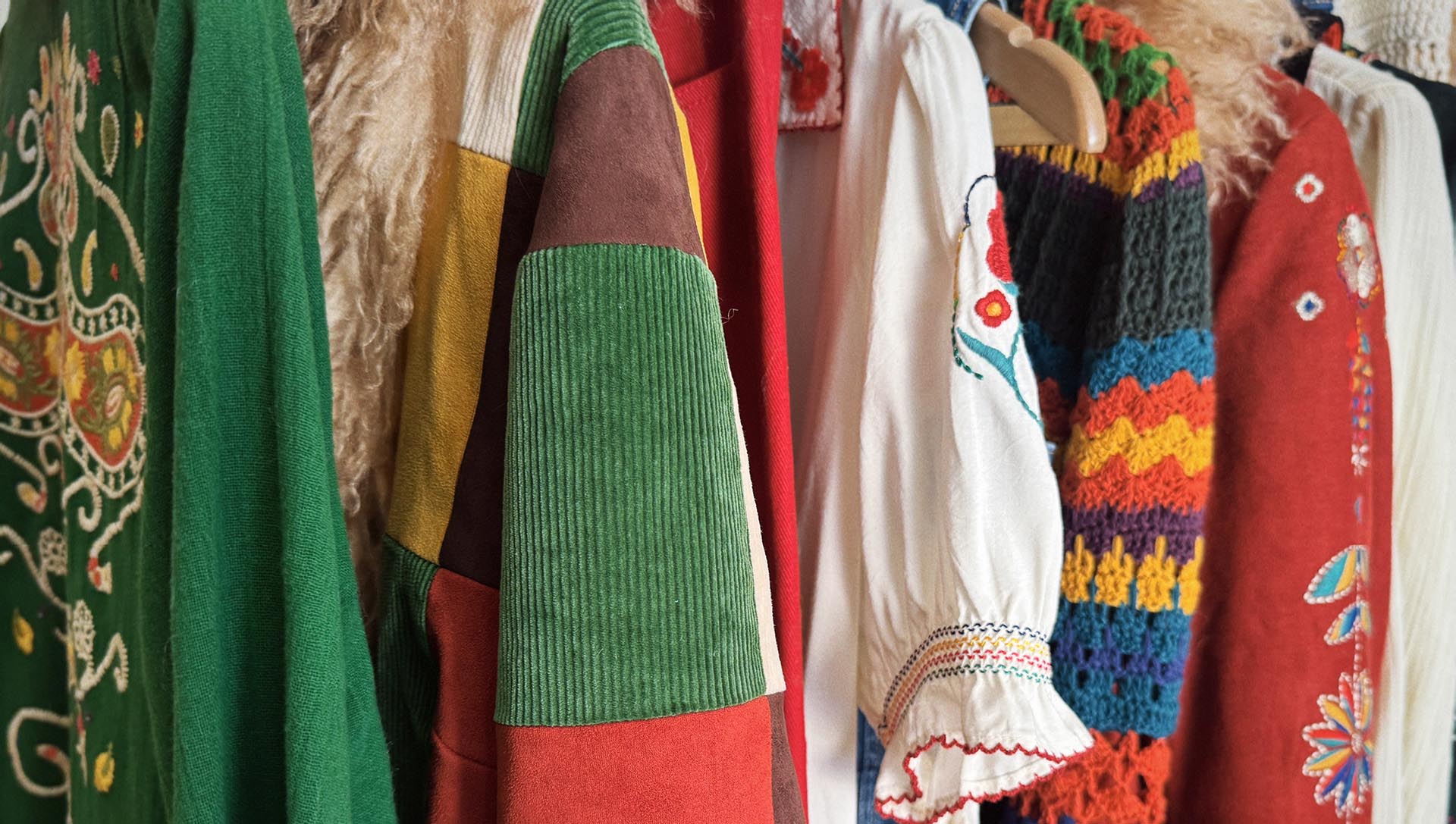At The Hippie Shake, every garment is a love song to the past and a promise for the future. We pour our heart into craftsmanship, slow fashion principles, and timeless design so that each piece can be a “treasure forever” in your wardrobe. Garment care is the next chapter of that story – it’s how you keep the magic alive. By taking care of your clothes with a gentle, loving touch, you’re honouring the nostalgia and artistry woven into every seam. In short, caring for your clothes means you can wear them on countless adventures (and maybe even pass them down one day), all while reducing waste and celebrating what makes each piece special.
Why garment care matters: We believe forever pieces deserve forever love. From the softest cotton blouse to a shimmering velvet dress, each material in our collection has its own personality – and a little TLC will help it shine for years. Below you’ll find friendly fabric-by-fabric tips on washing and preserving your Hippie Shake gems. It’s not just about keeping clothes clean; it’s about keeping the story going.

Caring for Cotton
Cotton is a natural, easy-going fabric – one that actually gets softer and cosier the more you wear and love it. Our vintage-inspired cotton pieces are durable, but treating them gently will keep colours vibrant and fibres strong for the long haul. Here’s how to care for your cotton classics so they stay forever young:
Washing: Use a cool or warm gentle cycle on your washing machine, or hand wash in cold water for extra care. (Cotton prefers mild detergent and similar colors together to avoid any dye drama.)
Drying: Skip the tumble dryer – high heat can cause cotton to shrink or lose its shape. Instead, reshape your garment and air dry it naturally. Hang it on a line or lay it flat in the shade; let the fresh air and sunshine do the work.
Ironing: If your cotton piece looks a little wrinkled, use a cool iron on the reverse side. Ironing inside-out (especially for printed or embroidered tops) keeps any artwork or intricate embroidery safe. Cotton smooths out easily with low heat, so you’ll have it looking fresh and ready for its next outing in no time.

Caring for Denim
Denim holds a bit of rock ’n’ roll spirit in every fibre – it’s the kind of fabric that tells a story with each fade and fray. We love our denim to feel well-loved and worn-in (it adds to that nostalgic vibe), so caring for it is all about not overdoing it. Treat your denim jackets and jeans with a gentle hand and they’ll stay iconic for years:
Washing: Wash denim sparingly. Unless it truly needs a clean, you can often just air it out or spot-clean small marks. When it’s time for a wash, turn your denim inside out and choose a cold, gentle cycle with similar colours. This keeps the wash gentle on the fibres and helps preserve those deep indigo blues or beautiful vintage dyes.
Drying: Avoid the dryer with denim as well – it can shrink fibres and dull the unique wash of the fabric. Instead, hang your denim to dry (inside out, in the shade to prevent fading) or lay it flat. Patience is key: your denim will reward you with a longer life and that perfectly worn-in feel.
Ironing: Denim typically doesn’t need much ironing (a few natural creases add character!). If you do want to press it, use a warm iron while the garment is still slightly damp, or spritz with water, then iron inside-out. A cloth between the iron and the denim can help protect any distressed details or patches. But honestly, we think a little wrinkle in denim just adds to the effortless vibes.

Caring for Viscose
Viscose has a gorgeous, drapey feel – you’ll notice it in many of our blouses and dresses that flow like a dream. It’s made from plant fibres (a bit of science and nature combined), giving it that silky, breathable quality. But viscose is also a sensitive soul, especially when wet, so it needs a tender touch:
Washing: Always go gentle with viscose. Hand washing in cold or lukewarm water with a mild detergent is ideal to prevent shrinking or warping. If you prefer machine washing, use a delicate cycle (cold water) and consider placing the item in a mesh laundry bag for protection. Avoid any harsh scrubbing – just a light swish in the water will do.
Drying: Viscose garments can become heavy when wet, so never twist or wring them out. Instead, press out excess water gently (you can lay the item on a clean towel, roll it up, and squeeze). To dry, it’s best to lay viscose flat on a towel or drying rack to avoid stretching. Keep it away from direct sunlight to prevent any colour fade. Patience here ensures your piece keeps its shape and that soft, slinky drape you love.
Ironing: Once fully dry, you might notice some creases – viscose can wrinkle. Use a cool iron on the reverse side, or even better, a steamer to relax the wrinkles. (Viscose responds well to steam.) Always iron inside-out to protect any prints or finishes. With low heat or steam, your viscose will smooth out and be ready to wear, retaining its effortless, flowy charm.

Caring for Rayon
Rayon is cut from a similar cloth as viscose – in fact, they’re like cousins in the fabric world, both derived from plant cellulose. You’ll find rayon in some of our lighter blouses and dresses where we want a soft, breathable feel. Caring for rayon is much like caring for viscose: gentleness is key to keep it looking and feeling dreamy.
Washing: Opt for a hand wash in cold water or a very gentle machine cycle for rayon pieces. Rayon can be prone to shrinking, so cold water is your friend. Use a mild detergent and avoid soaking for too long. If machine washing, a laundry bag is a good idea here too, to prevent any stretching or snagging.
Drying: Handle wet rayon with care – support the full garment when lifting it from the water (never pick it up from one corner, as it can stretch out). Lay it flat to dry on a towel or drying rack. If you prefer to hang, make sure it’s not a heavy sopping weight; gently smooth it out and hang in shade. As with viscose, keep rayon away from direct sun while drying to protect those rich colours.
Ironing: Use a low-heat iron on the inside of your rayon garment if needed. A steamer also works wonders to release wrinkles without direct contact. Make sure the piece is slightly damp or use a mist of water, then gently iron inside-out. In no time, your rayon will be ready – soft, drapey, and as vibrant as ever.

Caring for Coats (Polyester & Cotton lined)
Our statement coats (like the famous embroidered Penny Lane style coats) are loyal companions on chilly days – and they’re built to last through many winters if cared for properly. Often made with hearty polyester exteriors and cozy cotton linings, plus all kinds of intricate trims or faux furs, these coats prefer gentler cleaning methods. Here’s how to help your coat brave the seasons year after year:
Day-to-day care: You usually won’t need to wash your coat often. After wear, air it out on a hanger in a breezy spot to keep it fresh. If you get a little dirt or a spill on the surface, try a spot clean first: use a damp cloth to gently blot away the stain. (Be careful around any embroidery or embellishments – dab, don’t rub.)
Deep cleaning: For a full clean, we recommend professional dry cleaning for most of our coats. The mix of materials (and any vintage-style embroidery or faux-fur trims) will stay safest this way, maintaining the coat’s structure and details. Always check the care label – if it says “Dry Clean Only,” it’s best not to attempt machine washing. Trust us, a good dry cleaner will know how to pamper your coat.
Storage & ironing: Between outings, hang your coat on a sturdy hanger to keep its shape (avoid thin wire hangers that can cause bumps). Store it in a cool, dry place. If wrinkles appear, avoid direct ironing especially on polyester or decorated areas – instead, use a steamer or iron on a very low setting with a pressing cloth on top of the fabric. Never iron over embroidery or sequins. With these tips, your coat will remain the showstopper of every winter look for years to come.

Caring for Crochet (100% Cotton)
Our statement coats (like the famous embroidered Penny Lane style coats) are loyal companions on chilly days – and they’re built to last through many winters if cared for properly. Often made with hearty polyester exteriors and cozy cotton linings, plus all kinds of intricate trims or faux furs, these coats prefer gentler cleaning methods. Here’s how to help your coat brave the seasons year after year:
Day-to-day care: You usually won’t need to wash your coat often. After wear, air it out on a hanger in a breezy spot to keep it fresh. If you get a little dirt or a spill on the surface, try a spot clean first: use a damp cloth to gently blot away the stain. (Be careful around any embroidery or embellishments – dab, don’t rub.)
Deep cleaning: For a full clean, we recommend professional dry cleaning for most of our coats. The mix of materials (and any vintage-style embroidery or faux-fur trims) will stay safest this way, maintaining the coat’s structure and details. Always check the care label – if it says “Dry Clean Only,” it’s best not to attempt machine washing. Trust us, a good dry cleaner will know how to pamper your coat.
Storage & ironing: Between outings, hang your coat on a sturdy hanger to keep its shape (avoid thin wire hangers that can cause bumps). Store it in a cool, dry place. If wrinkles appear, avoid direct ironing especially on polyester or decorated areas – instead, use a steamer or iron on a very low setting with a pressing cloth on top of the fabric. Never iron over embroidery or sequins. With these tips, your coat will remain the showstopper of every winter look for years to come.

Caring for Velvet (Cotton & Viscose Blend)
Velvet is pure luxury and rockstar glamour rolled into one fabric – rich in colour, with a soft pile that catches the light. Our velvet pieces (often a cotton-viscose blend for that authentic vintage plush) are designed to turn heads, and with the right care, they’ll continue to do so for many years. Velvet does require a bit of extra love, but it’s worth it to preserve that sumptuous feel:
Washing: We typically do not recommend washing velvet at home – especially not in a machine. The agitation and water can flatten the velvet’s pile and ruin its texture. If your velvet item needs freshening, first try gently brushing the fabric with a soft clothes brush to remove any dust. For deeper cleaning, it’s best to go with dry cleaning. A professional cleaner will know how to clean velvet without harming its sheen or causing shrinkage. (Your garment’s care label will likely say dry clean only, and we agree.)
Spot care: Small spot or stain? Act quickly and blot (don’t rub) the area with a damp cloth. Because velvet is sensitive, avoid soaking it. Sometimes just letting a spill dry and then brushing the spot can work, as liquid often sits on the velvet surface briefly. There are also foam cleaners specifically for velvet that a professional might use.
Removing creases: Got some crush marks or creases in your velvet? Hang the garment in a steamy bathroom or use a steamer to gently lift the pile. You can also VERY lightly iron velvet inside-out on the lowest setting, but place a thick towel or ironing cloth over it and do not press down hard – you’re basically steaming it more than ironing. The goal is to avoid imprinting the pile. Storing your velvet hanging (with space around it) helps prevent long-term creasing or crushing. With gentle care, the velvet will stay dreamy and dramatic, ready to bring a bit of vintage glamour whenever you wear it.

Caring for Faux Leather Boots (Synthetic Leather)
Our faux leather boots are made for walkin’ – and dancing, adventuring, and everything in between – all while being 100% cruelty-free (no real leather here!). The good news: synthetic leather is pretty low-maintenance and sturdy, so caring for these boots is a breeze. A few simple habits will keep them looking sharp and festival-ready:
Cleaning: For everyday dirt and dust, a quick wipe-down does the trick. Use a damp cloth or sponge to gently clean the surface of your boots. Usually, that’s all you need – no soaps or heavy cleaners (they can strip the material). If you’ve been dancing in muddy fields, let any mud dry completely then brush it off gently before wiping.
Polishing: While faux leather doesn’t need conditioning like real leather does, you can still buff it up. After cleaning, dry the boots with a soft cloth and give them a light rub to bring back their shine. If the finish looks a bit dull, try a tiny dab of petroleum jelly or colourless shoe polish, and buff with a microfiber cloth.
Care & storage: Avoid extreme heat – don’t put your boots next to a heater or in direct sunlight for long periods, as the synthetic material can dry out or crack. If they get wet in the rain, wipe them and let them air-dry naturally (stuffing them with newspaper can help absorb moisture and maintain shape). Store your faux leather boots upright (you can even use boot shapers or rolled magazines to keep their form). This way they’ll be ready to rock whenever you are, without creases or cracks.

Caring for Faux Suede Boots (Synthetic Suede)
Faux suede offers that soft, velvety look of traditional suede but with easier upkeep – perfect for those embroidered western boots and 70s-style boots in our collection. Still, even hardy synthetic suede will appreciate some gentle care to keep it looking its best. Here’s how to help your faux suede footwear stay beautiful:
Cleaning: Start by brushing off any loose dirt or dust. A suede brush or even a clean soft toothbrush works well to lift debris without harming the texture. For scuffs or marks, use a damp cloth (just water, or water with a drop of mild soap) and gently blot the area. Remember not to soak faux suede; a little water goes a long way. For oil-based stains, sprinkling a bit of corn starch and letting it sit can absorb the oil before brushing off.
Drying: If your boots got a bit wet or you spot-cleaned them, let them air dry naturally. Keep them away from direct heat sources – high heat can cause the material to stiffen or the adhesive (that holds the boot together) to weaken. After drying, give them a quick brush to restore the nap (the soft, fibrous texture that makes suede, suede!).
Care & storage: To maintain that dreamy suede texture, occasionally brush your boots even when they’re not dirty – this keeps the nap fluffy and prevents dust from settling in. You can also use a protective spray for faux suede (make sure it’s labelled suitable for synthetics) to add a water-repellent layer; this is especially handy if you’ll be wearing them in damp conditions. Store your faux suede boots in a cool, dry place, ideally not squished under heavy items. Using tissue or boot shapers to help them hold shape is a great idea. With a little attention, your faux suede boots will carry you through many adventures, looking as soft and stylish as ever.











